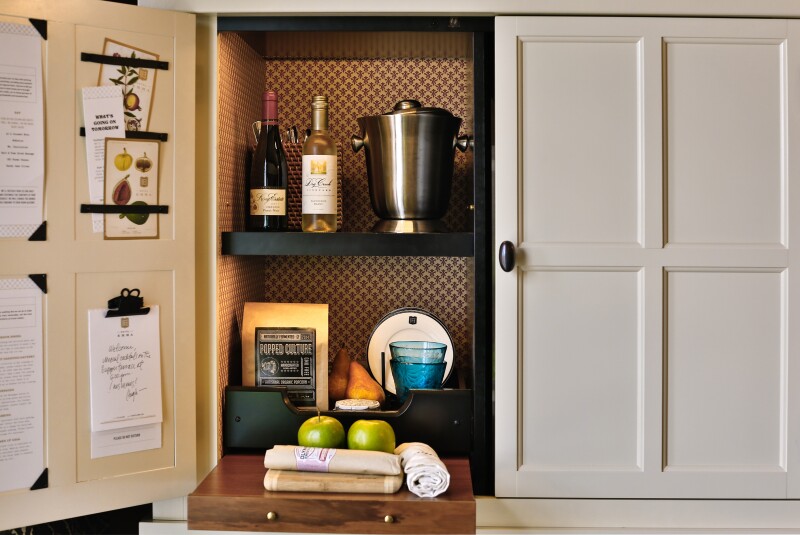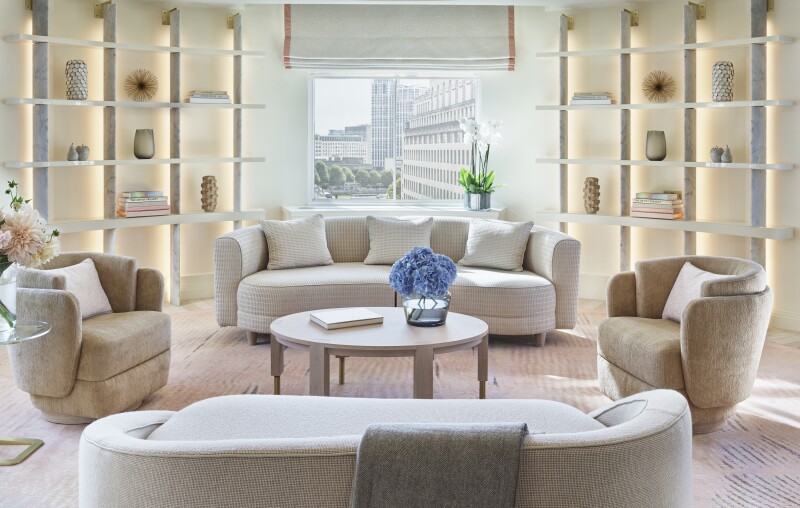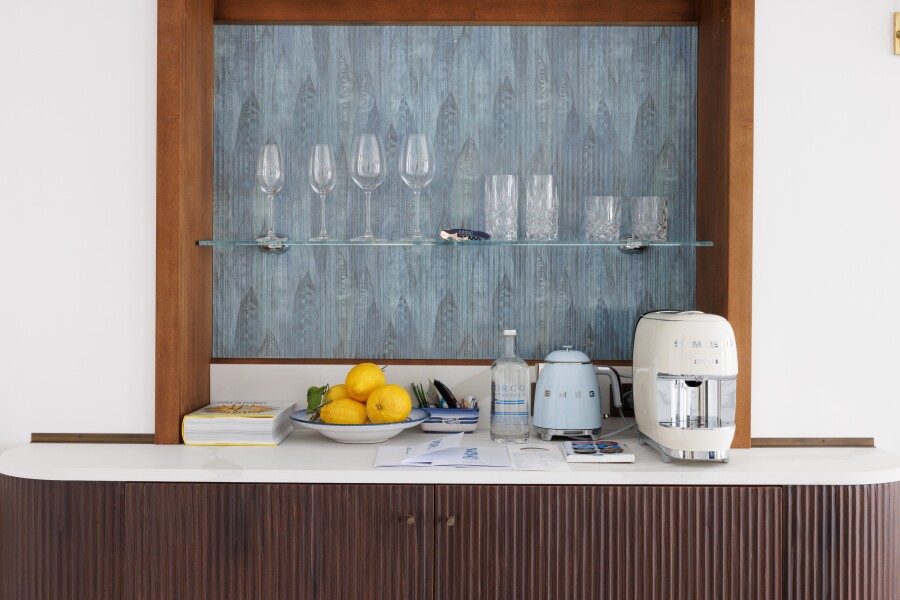Historically, minibar fare has been basic, to say the least: a lackluster sampling of canned sodas, miniature liquor bottles, mixed nuts, and exorbitantly priced M&Ms—all presented in a dorm-style mini fridge.
That generic selection no longer flies, at least at upscale properties across the globe, which are viewing in-room offerings less as perfunctory afterthoughts and more as an opportunity to give guests a taste of local flavors.
The new wave of minibars features everything from ready-made cocktails to adventurous gastronomical bites. Even furry friends are benefiting from these next-level minibars: At the Rittenhouse in Philadelphia, for example, a “Doggie Minibar” includes canine treats created in-house by the hotel’s pastry chef.
Some minibars are gratis minus the alcohol (where we’ve indicated below), while most charge fees that should be verified with the individual hotels. They may be custom designed by an architect to blend with modernist decor, like the minibar at the cliffside Borgo Santandrea on the Amalfi Coast, which features a blue feathered backdrop and ribbed wooden cabinetry. It’s stocked with local beer and wine, and snacks and soft drinks are complimentary.
Minibars can also be digital-only these days, like the “Penny Mart” at the poppy urban Penny Williamsburg hotel in Brooklyn, where rotating treats, sundries, beauty products, and even merch by local vendors and artists can be ordered 24-hours a day via an online app or in-room QR code. Cocktail offerings are common but differ by place. At eclectic 146-room Hotel Emma in the Pearl District of San Antonio (where the minibar is called an “Ice Box” in reference to south Texan–style “icehouse” gathering spots), guests open their fridges to find the makings of La Babia Margaritas, a local specialty originating at a nearby rancho. At the Rosewood São Paulo, in a landmark building with vertical gardens and Philippe Stark interiors, minibar cocktails are traditional Brazilian caçhaca-based Rabo di Galos.

A grand premier room at the Rosewood São Paulo
Courtesy of Rosewood São Paulo
Keeping guests healthy and happy is also a common priority. For example, if visitors (often A-listers) at ski-in/ski-out resort Little Nell in Aspen, Colorado are feeling the altitude, they’ll find an oxygen canister (for a fee) beside complimentary “chocolate stones” (sweet treats painted to look like multicolored rocks) and locally distilled Wood Creek vodka in their minibar. At Hoshinoya Tokyo, a 17-story hotel that plays on the theme of a traditional ryokan experience, guests can slip off their shoes and visit the communal minibar in the private lounge on the same floor as their guest room. There, they can hydrate with the Japanese sport drink Pocari Sweat or cleanse with azuki bean tea, on the house.
So, while these stashes of local-specific goodies may differ dramatically in terms of content and even focus, they strive to project the unique personality of the property and destination, supporting the local community, introducing guests to new culinary delights, and elevating the hotel experience with thoughtful touches.
Minibars customized to the changing seasons—and even personal tastes
It’s common for the upgraded minibars to rotate delights based on the season or new local artisan businesses. But they up the ante with personalization based on guests’ individual likes and dislikes. The complimentary minibar offerings at remote Eleven Deplar Farm, a rustic-chic property located on a converted sheep farm in northern Iceland, can include such delicacies as Omnom chocolate bars, Nóa-Kropp Chocolate Balls, and Icelandic beers including Sjarmör Lager and Naggur IPA, plus house-made herbal hummus, sesame crackers, and trail mix. But that all depends on a guest’s dietary restrictions, which are carefully considered before arrival.

An ochanoma lounge at Hoshinoya Tokyo
Courtesy of Hoshinoya Tokyo
At Buahan, a Banyan Tree Escape in Bali, guests can customize their minibar items online prior to arrival, choosing between fair trade Tema Tea (which uses 80 percent locally sourced ingredients from rural farmers) and Hungry Bird Roastery coffee. They can also customize their amenity kits, packaged in Balinese boxes made by local artisans with options like Bali Highland pork spice jerky and chicharron, house-made tempe crackers, and rempeyek kacang (crispy peanut crackers).
Personalization even extends beyond what’s edible to self-care products and home decor. The minibar at Las Alcobas in the swanky Polanco neighborhood of Mexico City, for example, stocks an assortment of handmade Manos Que Curan soaps by local herbalist Lilia Mendoza, alongside Mexican candies, snacks, and drinks. First-time guests are encouraged to identify their favorite bar, which is then placed in their room each time they return to the property.
Minibars as portals into philanthropy
Being able to support local businesses while sampling new creations is a win-win, but some properties are bolstering the community in more direct ways. In these cases, the minibar weaves philanthropy into its selections, like at MacArthur Place, a culinary-focused resort set on a sprawling Sonoma, California, estate, where the complimentary “Provisions Bar” is beloved for its local wine and sweets. The complimentary hot beverage options, which guests can prepare in clay mugs each morning on their private patios, are chosen for both their quality and ethos: Uppercase Tea donates 15 percent of sales to grassroots women’s nonprofit organizations, while Steeped Coffee puts 1 percent of revenue toward hunger relief and clean water charities. So, guests can caffeinate and do a good deed, simultaneously.
These charitable efforts often revolve around a local cause. In Encinitas, California, the Alila Marea Beach Resort—set atop a cliff with Pacific views—stays true to its coastal roots, offering up minibar options that benefit the ocean. Proceeds from locally based Solento Tequila—backed by some of the world’s best surfers—go toward the Solento Surf Festival, which supports the work of the Changing Tides Foundation to promote gender equity and social justice. Mizu reusable water bottles for sale benefit the Rob Machado Foundation for clean drinking water and oceans, too.
Similar ocean-based efforts occur in the U.S. Virgin Islands at the Lovango Resort & Beach Club, with rooms from glamping tents to villas set on a heavenly private island in the turquoise waters between St. John and St. Thomas. There, you can toast to your own good nature, sipping from the hotelier’s own locally distilled and eponymously named Little Gem Spirits, including Sweet Tamarind Rum, Caribbean Spice Whiskey, and Sorrel Lime Vodka. All the liquors are made from the surrounding breadfruit trees and benefit the Trees That Feed Foundation, which plants thousands across the Caribbean.

The minibar at the Emma Hotel in San Antonio features ingredients for margaritas.
Courtesy of the Emma Hotel
Sustainable, locally sourced products
Because many properties rely heavily on the beauty and bounty of their setting to lure and pamper guests, some are also using minibars to promote sustainability and preserve nature. Set against the dramatic backdrop of the Swiss Alps, the 56-room Earthcheck-certified gold Alpina Gstaad presents its eco-conscious minibars in restored antique wardrobes and snacks in regenerative wood boxes created by a local nonprofit. Here, the hotel takes the word “local” and the supply chain seriously: The complimentary goods—including Swiss sodas, Länggasse tea, herb salt, dried pear spread, and guest-favorite Choba Choba fair-trade chocolate-covered almonds—are sourced within 15 miles of the hotel and often from family-owned companies. Glass bottles are refilled with mountain water via a special filtration system to mitigate plastic production and waste.
Half a world away in Montana—at the also mountainous Ranch at Rock Creek, an all-inclusive resort set on a 19th century homestead—local water is presented in refillable glass bottles—and in canteens for adventure outings. In its glamping tents, the hotel also stocks recyclable aluminum bottles of Montana Silver Spring water—sourced straight from the mountain springs with a perfect pH of 7.8 and widely considered some of the purest water in the world. The complimentary minibars—housed in wood-paneled cabinets—include snacks like beef jerky from Kalispell and beer from Philipsburg Brewery—all local.
Hotel minibars that make you feel right at home

The Somerset Suite at the One Aldwych in London
Courtesy of the One Aldwych
The rise of residential-feeling luxury hotels has given rise to minibars that make guests feel like they’re right at home. Sometimes, that’s in the form of D.I.Y. offerings that allow visitors to create their own spreads as if they were at an upscale home. At One Aldwych, set in London’s bustling Covent Garden with serene guest rooms in muted pinks and creams, an individually curated “Personal Bar” stocks U.K.-centric libations, including Canned Wine Company (reducing the CO2 impact of heavyweight glass), Meantime British craft brew beer, and Franklin & Sons ginger beer and lemonade. But the hotel’s most specialized in-room offering is a cocktail-making collection, featuring silver-plated flutes by Robbe & Berking, so guests can play bartender and serve their own drinks.
In Austin, Texas, travelers who enjoy cheese with their wine and cocktails will appreciate the in-room offerings at Hotel Saint Cecilia, a design-centric Bunkhouse hipster haven. In addition to stocking local snacks and signature Nag Champa incense, guest rooms come with marble cheeseboards and the makings of an elaborate charcuterie spread, including espresso-rubbed cheddar, tinned Atlantic salmon, sardines, tomato and sultana chutney, rosemary crackers, and bourbon pecans.
At the luxurious Singita Sabora Tented Camp in Tanzania, within its contemporary-feeling tented accommodations, guests are treated to minibars inclusive of the rate with homemade cordials, nut balls, shortbread biscuits, and Afrikoa dark chocolate, made in Cape Town with cacao sourced from farmer cooperatives in Tanzania. There’s also a shared pantry and help-yourself bar in the main communal area and a Nutribullet in each glamping tent, so guests can use a bounty of fruit and other ingredients sourced from local horticultural co-ops to make their own smoothies as they might in their own kitchens back home.








